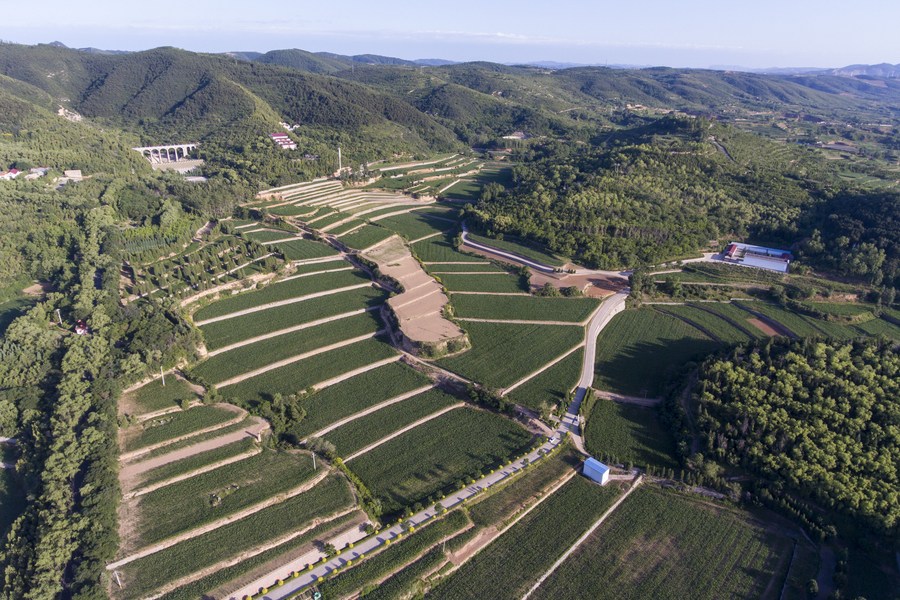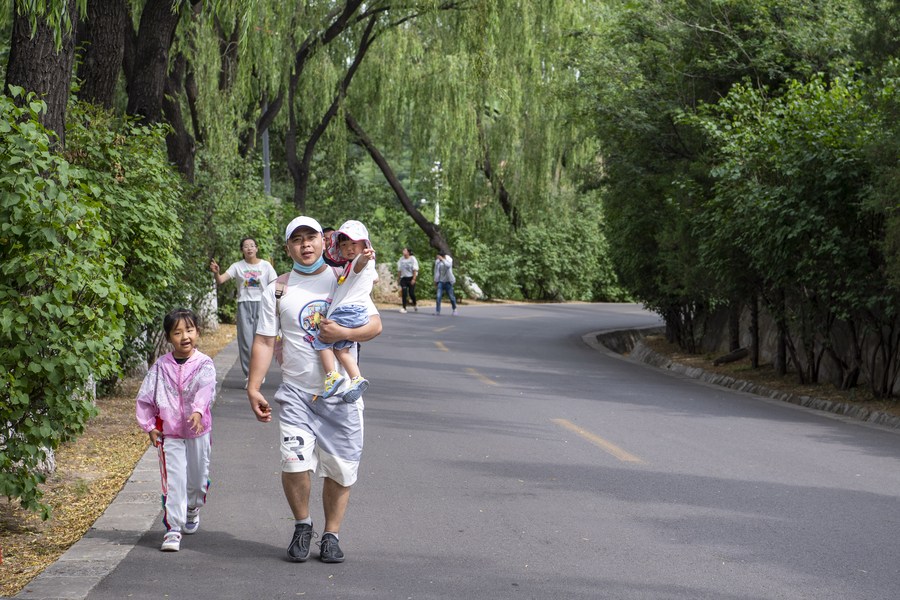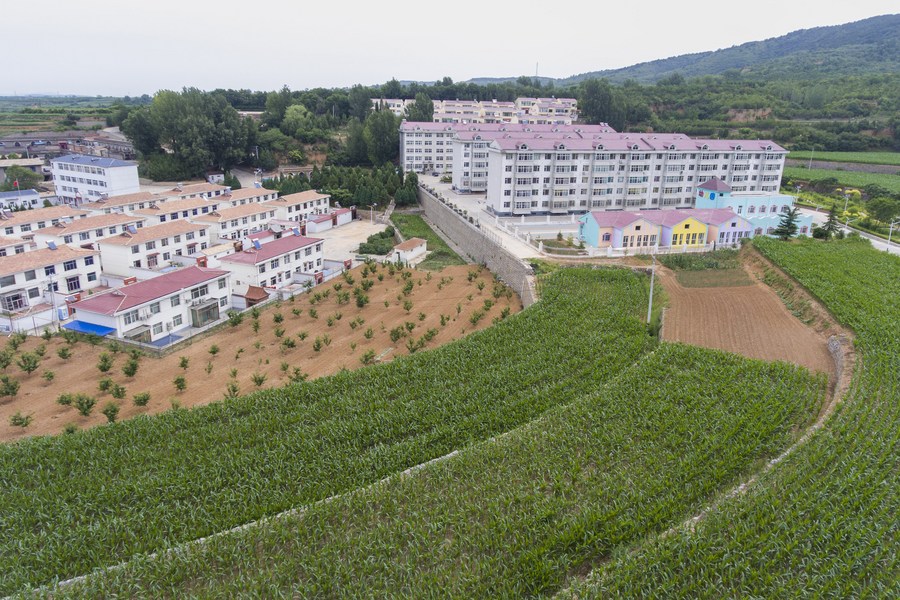-- Dazhai Village in north China's Shanxi Province was a national "pace-setter" of agriculture in the 1960s when late Chairman Mao Zedong had called on rural people nationwide to learn from the village's experience of reclaiming barren hillsides into terraced farmland.
-- Since the 1990s, the village embarked on a new journey of developing ecological tourism, which has brought considerable incomes and welfare to the locals.
-- Dazhai's story represents the changes of countless Chinese villages, where hard-working and smart farmers have fought their way to realize self-sufficiency, overcome poverty and achieve a life of moderate prosperity.
TAIYUAN, July 9 (Xinhua) -- Li Yuming, 85, has indelible memories of hunger, which persisted throughout his childhood and youth.
"Bark, leaves, wheat bran. We almost ate everything we could find," recalled the farmer in north China's Shanxi Province.
In order to fill their bellies, Li Yuming and fellow residents of Dazhai Village struggled to reclaim barren hillsides into high-yield terraced farmland in the 1960s-70s, achieving a miraculous feat that made Dazhai a national model of agriculture.
Since the 1990s, the village embarked on a new journey of developing ecological tourism, which has decorated the village with restaurants and museums and brought considerable incomes and welfare to the locals.
Dazhai's story represents the changes of countless Chinese villages, where hard-working and smart farmers have fought their way to realize self-sufficiency, overcome poverty and achieve a life of moderate prosperity.
"PACE-SETTER" VILLAGE
Hunger used to plague China. The country's total grain output was around 113 million tonnes in 1949, or 209 kg a head per year when the People's Republic of China was founded.
The mountain-locked and drought-prone Dazhai Village had little land to farm. In a bold attempt to overcome nature, locals began to open up mountains and fill ditches to build terraces, connecting scattered arable lands into layered belts by hillsides.
Stones dug out from the mountain had been built into dams beneath the terraces, which prevented the loss of water, soil and fertilizer.
Li Yuming joined the groundbreaking cause when he was 27. "We started at 4 a.m. and worked more than 10 hours every day," he recalled. "Without these terraces, my four kids could not have survived."

Aerial photo taken on July 1, 2021 shows a view of terraced fields in Dazhai Village of Jinzhong City, north China's Shanxi Province. (Xinhua/Yang Chenguang)
The success had made Dazhai a national "pace-setter village" of agriculture in the 1960s when late Chairman Mao Zedong had called on rural people nationwide to learn from the village's experience.
The Chinese government has always regarded issues relating to agriculture, rural areas and rural people as its top priority. After decades of promoting agricultural modernization across the country as well as the invention of the hybrid rice, Chinese no longer suffer from hunger.
In 2020, China's grain output reached 669.49 million tonnes, almost six times that of 1949, ensuring grain security for the world's most populous country.
TURNING GREEN TO GOLD
At Dazhai's heyday last century, about 10 million visitors from home and abroad had visited here to learn from its success or appreciate the agricultural landmark of New China.
Carrying on with past glory, Dazhai has taken up rural tourism in the 1990s as a pillar industry to get rich. The renowned terraces have completed their mission of feeding the village, and are gradually being replaced with vegetation.
"There were about 53.3 hectares of terraced fields in Dazhai, and over one-third of them have been returned to forest," said Li Haibin, an official of the village, adding that the village now sticks to the path of green development.
Over the past 20 years, the village has invested more than 100 million yuan (about 15.42 million U.S. dollars) in infrastructure construction. In 2019, Dazhai was listed in the first batch of national key villages for rural tourism and was recognized as a National Forest Village by the Forestry and Grassland Administration that same year.
According to Li Haibin, as many as 300,000 people come to visit the small village every year, and tourism revenue has become the major source of income for over 500 residents in Dazhai.

Tourists visit Dazhai Village of Jinzhong City, north China's Shanxi Province, July 2, 2021. (Xinhua/Yang Chenguang)
Both Li Yuming's son and grandson work for a local tourism company. Li Zhenjiang, the grandson, also runs two souvenir shops, earning over 100,000 yuan annually in total.
"Every household in Dazhai is a shareholder of the tourism company, and receives a dividend of 3,000 yuan each year," said 73-year-old Guo Fenglian, founder of the company. Guo was reputed the "iron woman" for leading her fellows to fight harsh natural conditions in agricultural development. She established a group for local development covering various sectors in the 1990s.
LEADING A XIAOKANG LIFE
On July 1, China announced that it has realized its first centenary goal -- building a moderately prosperous society in all respects.
The achieving of moderate prosperity, or Xiaokang in Chinese, is measured in multiple aspects. In terms of economy, Xiaokang requires doubling China's 2010 GDP and per capita disposable income by 2020.
Though not very clear about the exact definition of Xiaokang, Li Yuming is sure that he is "living such a good life that I couldn't even dare to dream of in my childhood."
In Dazhai, the collective income reached 23 million yuan last year, with the per capita income exceeding 26,000 yuan. Residents live in houses built by the village, which share central heating, water supply and sewage treatment, just like in the cities.
Moreover, Guo's tourism company issues 1,000 yuan to each villager in welfare annually. People over 60 years old can receive 200 yuan per month while those over 70 get 300 yuan from the company.

Aerial photo taken on July 2, 2021 shows a view of Dazhai Village of Jinzhong City, north China's Shanxi Province. (Xinhua/Yang Chenguang)
Behind the continuous improvement of the living standards is the unswerving pursuit of the Communist Party of China to seek happiness for the Chinese people and rejuvenate the nation. In 2020, China's GDP exceeded 100 trillion yuan, and the per capita GDP has exceeded 10,000 U.S. dollars for two consecutive years.
In the past eight years, China focused on areas of extreme poverty and lifted the final 98.99 million impoverished rural residents out of poverty by the end of 2020.
Li Zhenjiang used to work in Beijing, but life in his hometown became more alluring, making him determined to come back and settle down.
"The village has kindergartens, schools, daycare centers for seniors, as well as various recreational facilities. The environment is good and life is really comfortable here," said the man in his early 30s.
He now truly understands why people say "lucid waters and lush mountains are invaluable assets." "We will take good care of the forest to further develop tourism in Dazhai. Our future relies on it," he added.
(Video reporter: Zhao Yang, video editor: Peng Ying) ■




